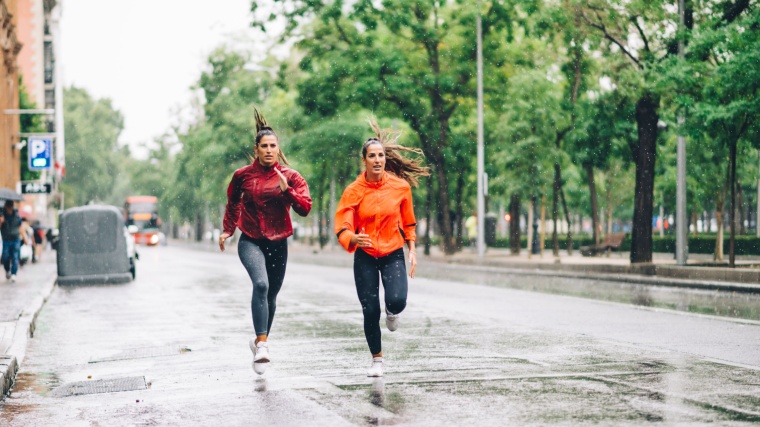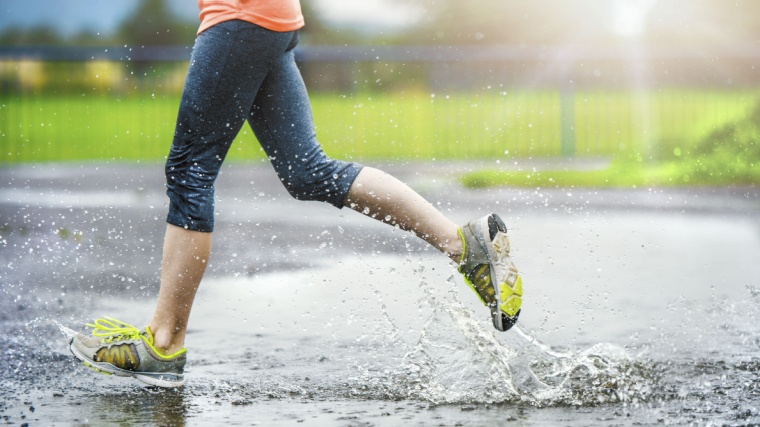You were just about to head outside for a late afternoon run when the skies opened up and the rain began to fall. The daily forecast leaves you with no reason to suspect the rain will let up anytime soon, but you can’t worry about such things; you’ve got a 5K to get in shape for, and no time to waste.

But before you zip up your windbreaker, you want to make sure your run is as safe and healthy as you can make it. Taking the right precautions can keep a simple run through the park from feeling like a swim through a dark lake. To get you the best tips out there, I sat down with Lee Whitaker, who is certified as an expert running coach by U.S. Track & Field and a world-class ultra-distance runner. Here are your rain run essentials.
Is Running in the Rain Safe?
Running in the rain is usually less safe than running in dry weather, but that doesn’t mean it’s inherently dangerous. Obviously, there is a great deal of difference between a drizzle and a downpour, so the severity of the rain is going to be a factor. Aside from that, you can reduce much of the potential danger simply by taking the proper precautions.
Tips for Running Safely in the Rain
To pull together a helpful list of rainy day running tips for you, Whitaker and I had a chat about your next inclement weather jog. If anyone can give you the confidence to run faster — even if some of that running takes place in bad weather — it’s Whitaker.
Wear Visibility Gear
If you’re heading out for a run in the pouring rain, there’s a good chance that your vision is going to be obscured, along with everyone else’s. For the sake of your own ability to see, you may wish to wear a visor as you run through wet weather. Aside from that, you should also do your part to make sure drivers can spot you before your run becomes unnecessarily hazardous.
“Any time that you’re going to run during mornings, or at dusk, or during low-visibility times like rain or fog or anything like that, I think it’s definitely a smart thing to put on some sort of bright colored clothes, a vest, or some sort of reflective gear,” advises Whitaker. “Even outfits that have lights or blinking LEDs on them are helpful.”
[Read More: The Best Men’s Headbands For Sweat-Wicking, Tennis, and More]
Wear Lighter Clothes
Wet clothes and wet shoes can take much of the enjoyment out of a run. Fortunately, you can acquire clothing options that can keep your run pleasant, from a waterproof jacket down to waterproof running shoes. In short, you may want to invest in some clothing that is moisture-wicking, or water-resistant, to combat the damp weather conditions.
“When clothes get wet, they’re going to get heavier,” says Whitaker. “You want really lightweight stuff on so that you’re not carrying so much external water weight. Big heavy cotton t-shirts or sweatshirts are going to get so much heavier because they’re going to absorb and hold so much water.”
[Read More: How Muscular Athletes Can Still Find Great Fitting Clothes]
Take Special Precautions in the Cold
Taking a rainy run is one thing, but running in a mixture of rain and cold weather adds layers of complexity to the equation. In response, Whitaker advices you to include two layers of clothes — an outer layer of clothing and an inner base layer — including a specialty long-sleeve shirt. This combination can help to keep your body temperature at a safe level during winter running.

“I like two layers: A tight, compression layer that wicks moisture off from the skin, and something a little looser over it to keep some warmth in but get the moisture off the skin,” says Whitaker. “I also like to cover the extremities like my hands and head with gloves and a hat. Your fingers and head will usually be the coldest things because they’re extremities.”
[Read More: The Best Supplements for Runners]
Don’t Overthink Your Stride or Pace
Aside from the general annoyance caused by raindrops, the water can create dangerous obstacles when they land. Puddles can be an inconvenience in any setting, but if you’re in the midst of trail running, loose mud can disrupt your footing and cause you to fall. Aside from wearing trail running shoes and the right gear, you’re encouraged to remain vigilant without altering your stride too much.
“Once the surface that you’re running on is wet, or if it gets slick, you tend to instinctively adjust to the situation that’s in front of you,” Whitaker muses. “I don’t think you should make an intentional or conscious effort to alter your stride just because it’s raining. You should adjust it situationally for purposes of safety if you’re trying to make sure your footing is sure and you’re not slipping or sliding.”
[Read More: Running on a Treadmill Vs. Running Outside — Which Is Best for Your Goals?]
Protect Your Phone
Wearing the right rain jacket during your rainy day runs is primarily about protecting yourself, but keeping your phone safe should also be a priority. You may want to make sure your rain jacket has a safe pocket to stash your phone in. If not, there are other ways to keep your phone safe during a downpour even if your running gear won’t do an adequate job of keeping your phone dry.
“A lot of runners have special protective gear for their phones,” notes Whitaker. “You can buy, wear, or carry whatever you want. The thing is, a plastic bag works pretty darn well, too. I put my phone in a Ziploc bag and tuck it into a side pocket, and it works fantastic.”
[Read More: Best Armband Phone Holders]
Prepare for Discomfort
Aside from the sensations of feeling cold and wet, the presence of moisture has other effects on your body that can be unpleasant, especially as you continue to move. This includes additional friction from your shoes and clothing. Beginners may want to take heed and invest in an anti-chafing aid like Body Glide or blister pads to prevent a painful round of chafing or blisters. (1)
“You need to make sure to take precautions because you’re going to get wet, your shoes are going to get wet, your socks are going to get wet, and all of that raises the likelihood of chafing and blisters,” cautions Whitaker. “If you’re going to choose to run in the rain, make sure you’re wearing clothes that work well being wet and you use some sort of lubrication or blister pads if you’re prone to chafing.”
[Read More: How to Achieve Proper Running Form, Explained By Running Coaches]
When Should You NOT Run in the Rain?
As cool as all of the modern running devices and paraphernalia are, there are some weather conditions that simply can’t be overcome by a fancy pair of shoes and a hydrodynamic running jacket. In those situations, the risk vastly outweighs the reward, and you’re better off finding a treadmill or an exercise bike, or maybe even — gasp! — giving yourself a rest day.
When Weather Is Dangerous
You may have been told that jogging through rainy weather will help you develop the necessary mental toughness to achieve your best performance on race day. That may be true, but even the Boston Marathon is likely to be delayed or canceled on account of thunderstorms. It’s perfectly reasonable to delay a workout if the heavy rain or high winds are simply too oppressive.

“Probably the only circumstances in which I would say you shouldn’t run is if the wind and thunder and lightning are too much to overcome. Also, if it’s especially cold outside, you’re risking hypothermia.”
[Read More: The Best Stability Running Shoes, Tested and Trialed by Our Team]
When You Don’t Have the Right Clothes Available
The potential benefits of a single outdoor run aren’t worth the risks of making yourself sick or finding yourself at the mercy of a distracted driver. If you don’t have bright or reflective clothes on hand, you’re better off not going.
“If you don’t have anything on that helps drivers see you in the dark, or you’re likely to make yourself sick because you don’t have the right clothes available, it’s probably not a good idea to go running even if you think you would be safe outside otherwise,” says Whitaker. “There’s no sense in creating a dangerous situation for yourself simply because you don’t have the right clothes or other stuff around to ensure your safety.”
Frequently Asked Questions
Running in the rain can be exhilarating. Here are the answers to questions you probably have before you head out.
Is it OK to run in the rain?
The decision to run in the rain is usually a matter of personal comfort. However, severe weather can make it far too risky to run in the rain, as does a lack of high-visibility clothing to ensure that drivers can spot you running by the road. You should use your best judgment to determine whether conditions are sufficiently safe for you to run.
What precautions should I take when running in the rain to avoid getting sick?
The reason you might get sick as a result of being cold and wet is because your body temperature drops and hinders the responsiveness of your immune system. (2) To avoid this, you should warm up prior to running, make sure you wear enough layers of clothing during your run, and then dry off and seek warmth as soon as your run is over.
How do you long-distance run in the rain?
Before beginning a long-distance run in the rain, you should ensure that you are adequately protected from the cold, wet weather. This requires you to wear the right attire, including gloves and a hat if necessary. It also includes reflective gear or lights to ensure that drivers can see you.
How can I keep my feet dry while running in the rain?
You likely can’t keep your feet perfectly dry while running in the rain for extended periods. However, you can minimize the discomfort caused to your feet by the wetness by wearing thin, moisture-wicking socks and waterproof shoes.
Editor’s Note: The content on BarBend is meant to be informative in nature, but it should not be taken as medical advice. When starting a new training regimen and/or diet, it is always a good idea to consult with a trusted medical professional. We are not a medical resource. The opinions and articles on this site are not intended for use as diagnosis, prevention, and/or treatment of health problems. They are not substitutes for consulting a qualified medical professional.
References
- Rushton R, Richie D. Friction Blisters of the Feet: A New Paradigm to Explain Causation. J Athl Train. 2024 Jan 1;59(1):1-7.
- Huang D, Taha MS, Nocera AL, Workman AD, Amiji MM, Bleier BS. Cold exposure impairs extracellular vesicle swarm-mediated nasal antiviral immunity. J Allergy Clin Immunol. 2023 Feb;151(2):509-525.e8.
Featured Image: PeopleImages.com – Yuri A / Shutterstock